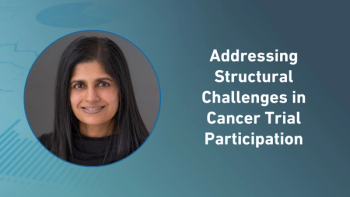
- Applied Clinical Trials-11-01-2024
- Volume 33
- Issue 11
Recruiting Clinical Trial Participants: How to Balance Data and Trust
Understanding how the dynamics between the two play hand in hand in influencing patient recruitment and retention.
In the world of clinical trials, patient recruitment remains a persistent challenge. Despite technological advancements, up to 80% of trials still fail to meet enrollment timelines, leading to delays and increased costs.1 At TrialScreen, we engage daily with sponsors, contract research organizations, and site management organizations striving to enhance recruitment dynamics for their projects. These discussions often revolve around whether to invest in data-focused or trust-based recruitment interventions. Understanding how both data and trust influence patient recruitment and retention is vital for improving operational outcomes.
The data revolution
The availability of rich patient data has transformed recruitment strategies. Electronic health record and real-world data now offer unprecedented insights into potential trial participants. Brett Kleger, CEO of Inspire, notes, “We’re seeing a shift toward more targeted, data-driven approaches. AI and machine learning are being leveraged to predict which patients are most likely to be eligible and interested in specific trials.”
However, data alone is not a panacea. Kleger cautions, “While data can tell us who might be eligible, it doesn’t necessarily tell us who will participate. There’s a human element that can’t be captured by algorithms alone.”
The irreplaceable role of trust
The importance of trust and relationships in clinical trial recruitment cannot be overstated. “When you think about going into a clinical trial, it’s mostly about the relationship that the patient has with the physician,” Kleger emphasizes. This highlights the critical role of site-patient relationships in both recruitment and retention.
Building trust, especially in communities with historical mistrust of clinical research, requires sustained effort. Community engagement and education are key to addressing misconceptions and increasing participation rates.
Synergizing data and trust
The future of effective clinical trial recruitment lies in the synergy between data-driven approaches and trust-building efforts. Kleger explains, “Data can inform where and how we build relationships. For instance, we can use data to identify communities with high prevalence of a condition, then tailor our outreach and education efforts to those specific populations.”
Elisa Cascade, chief product officer at Advarra and Association of Clinical Research Professionals board chair, adds nuance to this perspective. She notes, “While both data and trust relationships are important, they serve different purposes and likely vary based on the trial indication/design.”
Tailoring approaches to trial types
For easily recruited studies, such as vaccine trials with broad inclusion criteria, trust relationships may suffice. However, in narrower indications like rare diseases, data becomes crucial for identifying potential candidates.
Cascade also notes the role of patient motivation: “One of the greatest drivers of clinical trial interest was a patient’s lack of satisfaction with their medication, including bothersome side effects. When you have patients who truly have unmet medical need and who are motivated to seek new options, data and relationships may play a lesser role.”
- Leverage data responsibly. Use big data to identify potential participants, but remember that eligibility doesn’t equal willingness.
- Prioritize relationship-building. Invest in building trust with patients and communities, potentially partnering with patient advocacy groups or community leaders.
- Personalize outreach. Use data insights to tailor communication and education efforts to specific patient populations.
- Ensure prompt follow-up. As Cascade notes, “If we refer the patient to a site, and the site fails to promptly follow-up, then that patient will never convert anyway.”
- Cultivate disease-specific communities. In rare disease, proactively build relationships with patient groups before study initiation.
The question of whether clinical trial recruitment is a data problem or a trust challenge is, in reality, a false dichotomy. Successful recruitment strategies must leverage the strengths of both approaches, tailored to the specific needs of each trial. By bridging the gap between data-driven insights and trust-based approaches, we can create more efficient, effective, and inclusive trials, ultimately accelerating the development of new therapies for patients in need.
Hugo Stephenson, MD, is Co-Founder and Executive Chair, TrialScreen
* This is Stephenson’s first installment as a regular contributor to Applied Clinical Trials’ print and digital editions, where he will explore critical topics and challenges in patient recruitment, engagement, and diversity in global clinical trials. A physician, entrepreneur, and thought leader, Stephenson has founded disruptive initiatives such as Quintiles’ Global Late Phase Services, MediGuard, DrugDev, and now TrialScreen.
Reference
1. Chaudhari, N.; Ravi, R.; Gogtay, N.J.; Thatte, U.M. Recruitment and Retention of the Participants in Clinical Trials: Challenges and Solutions. Perspect Clin Res. 2020. 11 (2), 64-69. doi:
Articles in this issue
about 1 year ago
Applied Clinical Trials November 2024 Issue (PDF)about 1 year ago
Advancing for Patientsabout 1 year ago
Enhancing Empowerment in Patient-Focused Researchabout 1 year ago
Are Any Data in Clinical Trials Better than No Data At All?about 1 year ago
Harnessing Unstructured Data and Hospital InteroperabilityNewsletter
Stay current in clinical research with Applied Clinical Trials, providing expert insights, regulatory updates, and practical strategies for successful clinical trial design and execution.




